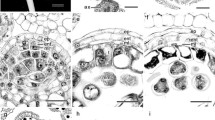Abstract
The embryology and seed development ofDactyliandra welwitschii Hook. f., a monotypic species of Cucurbitaceae, is studied. The inferior, tricarpellary, unilocular ovary with parietal placentation bears anatropous, bitegmic and crassinucellate ovules singly at the tip of each lobe of the bifid placenta. The deep seated megaspore mother cell undergoes meiosis to form a linear tetrad of megaspores. The chalazal megaspore is functional and embryo sac development follows the Polygonum type. Fertilization is porogamous and pollen tube is persistent.
Endosperm is nuclear with a short chalazal haustorium. The wall formation is progressive and the haustorium remains coenocytic. Embryogeny is of the Asterad type. The testa develops from the outer integument alone while the inner degenerates soon after fertilization. The mature seed coat comprises the seed epidermis, 8–10-layered sclerotic hypodermis, main sclerenchymatous layer of vertically elongated astrosclereids, aerenchyma and the inner zone.
Similar content being viewed by others
References
Bhandari, M. M. and Singh, D.,Dactyliandra (Hook. f.) Hook. f. a cucurbitaceous to genus new to the Indian flora.Kew. Bull. 19 133–138 (1964).
Chakravarty, H. L., Monograph on Indian Cucurbitaceae.Rec. bot. Surv. India 17 1–234 (1959).
Chopra, R. N., Some observations on endosperm development in the Cucurbitaceae.Phytomorphology 5 219–230 (1955).
Chopra, R. N. and Agrawal, S., Some further observations on the endosperm haustoria in the Cucurbitaceae.Phytomorphology 8 194–201 (1958).
Chopra, R. N. and Agrawal, S., The female gametophyte ofBenincasa cerifera Savi.Bot. Notiser 113 192–202 (1960).
Crété, P., Embryogenie des Cucurbitacees. Developpement de l’ albumen et de l’embryon chez laSicyos angulata.C.r. hebd. Seanc. Acad. Sci. Paris 246 456–459 (1958).
Crété, P., Embryogenie des Cucurbitacees. Developpement de l’ embryon chez leEcballium elaterium.C.r. hebd. Seanc. Acad. Sci. Paris 251 968–970 (1960).
Crété, P., Embryogenie des Cucurbitacees. Developpement de l’ embryon chez leCyclanthera explodens Naud.C.r. hebd. Seanc. Acad. Sci. Paris 254 3411–3412 (1962).
Dathan, A. S. R., Structure and development of seeds of Cucurbitaceae and some of its related families.Ph.D. Thesis, Rajasthan Univ. (1971).
Davis, G. L.,Systematic Embryology of the Angiosperms, John Wiley & Sons, New York (1966).
Dzevaltovsky, A. K., Peculiarities of development of the female gametophyte inMomordica charantia L. (in Russian).Ukr. Bot. J. 20 53–60 (1963).
Johanson, D. A.,Plant Embryology, Waltham, Mass. U.S.A. (1950).
Kirkwood, J. E., Comparative embryology of the Cucurbitaceae.N.Y. Bot. Gdn. 3 313–402 (1904).
Netolitzky, F., Anatomie der Angiospermensamen, Berlin (1926).
Schnarf, K.,Vergleichendle Embryologie der Angiospermen, Berlin (1931).
Singh, B., Studies on the structure and development of seeds of Cucurbitaceae. 1. Seeds ofEchinocystis wrightii, Cogn.,Phytomorphology 2 201–209 (1952).
Singh, B., Studies on the structure and development of seeds of cucurbitaceae.Phytomorphology 3 224–239 (1953).
Singh, D., Embryological studies inCucumis melo var.pubescens Willd.J. Indian bot. Soc. 34 72–78 (1955).
Singh, D., A contribution to the embryology of some members of the family Cucurbitaceae.Proc. Indian Sci. Congr. 3 222–223 (1956).
Singh, D., Studies on endosperm and development of seed in Cucurbitaceae and some of its relate families.Ph.D. Thesis, Agra Univ. (1959).
Singh, D., Development of embryo in the Cucurbitaceae.J. Indian bot. Soc. 40 620–623 (1961).
Singh, D., A further contribution to the endosperm of the Cucurbitaceae.Proc. Indian Acad Sci. 60 B 399–413 (1964).
Singh, D., Ovule and seed ofDicoelospermum C. B. Clarke together with a note on its systematic position.J. Indian bot. Soc. 44 183–190 (1965).
Singh, D., Structure and development of seed coat in Cucurbitaceae. III. Seeds ofMomordica andRaphanocarpus Hook. f.Proc. Indian Sci. Congr. 3 347–348 (1968).
Singh, D., Cucurbitaceae. In ‘Comparative Embryology of Angiosperms’.Bull. Indian natl. Sci. Acad. 41 212–219 (1970).
Singh, D. and Dathan, A. S. R., Morphology and embryology ofMarah macrocarpa Greene.Proc. Indian Acad. Sci. 73 B 241–250 (1971).
Singh, D. and Dathan, A. S. R., Development of generative and aposporic embryo sacs inCucumis metuliferus E. Mey. ex. Schrad.Curr. Sci. 41 33–35 (1972).
Sougés, R., Embroygenie des Cucurbitacees. Developpement de l’embryon chez leBryonio dioica.C.r. hebd. Seanc. Acad. Sci. Paris 208 227–229 (1939).
Willis, J. C.,A Dictionary of the Flowering Plants and Ferns, Cambridge Univ. Press (1966) (Revised by Airy-Shaw).
Author information
Authors and Affiliations
Additional information
Communicated by Prof. K. S. Thind,f.a.sc.
Rights and permissions
About this article
Cite this article
Dathan, A.S.R. Embryology and seed development ofDactyliandra welwitschii Hook. f.. Proc. Indian Acad. Sci. 80, 207–215 (1974). https://doi.org/10.1007/BF03050666
Received:
Revised:
Issue Date:
DOI: https://doi.org/10.1007/BF03050666




